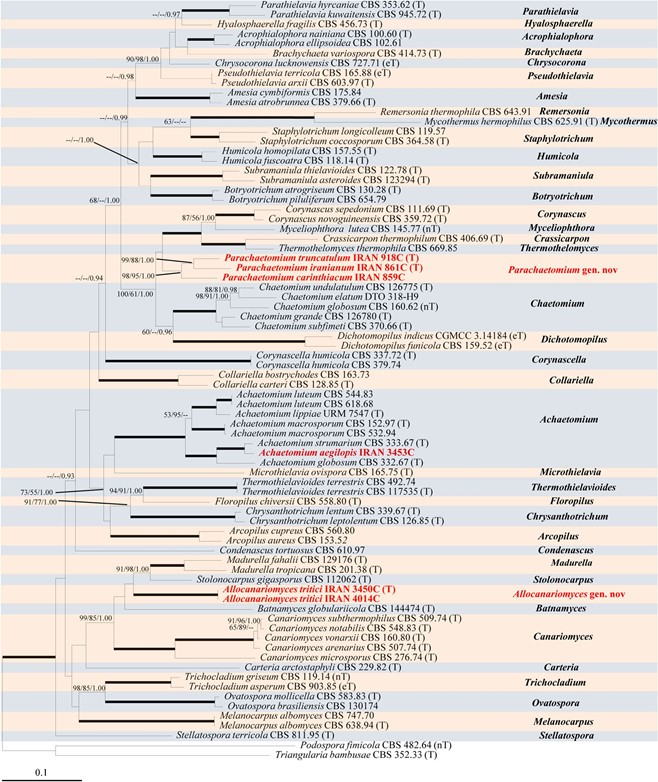Parachaetomium Mehrabi, Asgari & Zare, Mycol. Progr. 19(12): 1422 (2020)
Index Fungorum number: IF 835855; MycoBank number: MB 835855; Facesoffungi number: FoF 14632
Etymology – Name refers to a genus morphologically simi- lar to, but phylogenetically distinguishable from Chaetomium.
Diagnosis – For morphological similarities and differences between Parachaetomium and other genera in the Chaetomiaceae, see below.
Sexual morph: Ascomata gray or olivaceous in reflected light, globose to subglobose or ovate, solitary, distinctly ostiolate, with a wide apical pore, non-translucent, typically up to 200 μm diam; cells of ascomatal wall arranged in textura intricata, t. angularis or t. irregularis in surface view. Ascomatal hairs long, flexuous, wavy or regularly coiled, some short, arcuate, verrucose, spiny, or warty. Asci fasciculate, fusiform or clavate, short-stalked, eight-spored, evanescent. Ascospores biseriate or irregularly distributed in ascus, pale grayish- or bluish-brown to dark olivaceous-brown, one-celled, smooth, equi- or inequilaterally fusiform, typically 13 μm long, with an oblique or subapical, occasionally apical germ pore. Asexual morph not observed.
Type species – Parachaetomium iranianum (Asgari & Zare) Mehrabi, Asgari & Zare
Notes – In our phylogenetic analysis (Fig. 1), ex-type strains of the newly combined taxa, Parachaetomium carinthiacum, P. iranianum, and P. truncatulum were grouped together and formed a well-supported monophyletic lineage (98%/95%/ 00). The new genus Parachaetomium grouped within a clade including members of Chaetomium, Corynascus, Crassicarpon, Dichotomopilus, Myceliophthora, and Thermothelomyces (100%/61%/1.00, Fig. 1).

Fig. 1 RAxML tree based on analyses of a combined dataset of ITS, LSU, TUB2, and RPB2 sequences. Bootstrap support values for ML (ML-BS) and MP (MP-BS) ≥ 50% and Bayesian posterior probabilities (PP) ≥ 0.90 are shown as ML/MP/BI above or below the nodes. The branches with full statistical support (ML-BS = 100%; MP-BS = 100%; PP = 1.0) are thickened. Newly described taxa are shown in red typeface. The scale bar shows the expected number of changes per site. The tree is rooted in Podospora fimicola and Triangularia bambusae (Podosporaceae). (T), ex-type strain; (eT), ex-epitype strain; (nT), ex- neotype strain
Species
